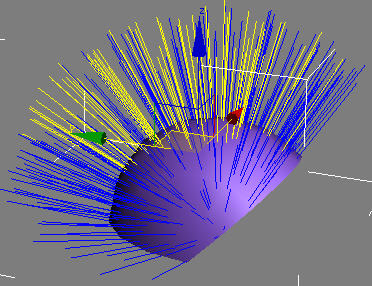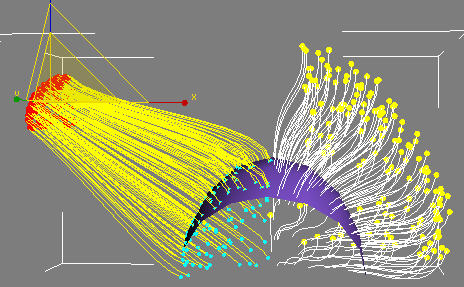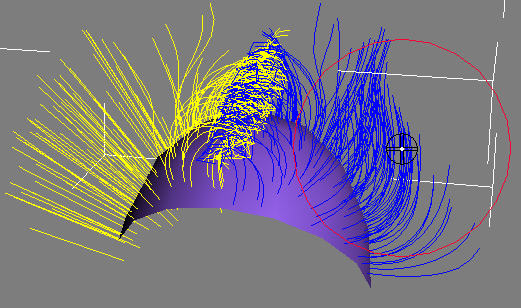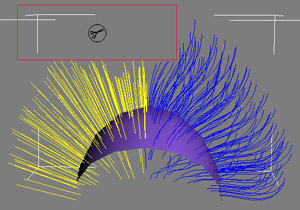| EDIT GUIDES
Edit guides is a modifier created for the sole purpose of modifying sparse state of hair. Here the user is presented with a toolset that allows easy and intuitive manipulation of hair. This modifier is broken down into three main sections (or levels) of guide editing. Using these three methods together should allow you to produce any arbitrary hair volume shape, which can then be fine-tuned using hair state modifiers.
Global parameters: Hide/Freeze - Puts strands into a hidden or frozen mode. This is useful when dealing with a hair model consisting of many guides. Cull back-facing roots - If this option is on, any strands facing away from the viewport will behave as frozen. Hide back-facing roots - Same as previous option, except this option will actually hide all roots facing away from the viewport.
Root level 
[ Strands are edited according to their root. This implies that every strand is treates as its own solid component ] Root portion of edit guides is designed around the workflow of dealing with hair roots (for definition of root refer here). There are some fundamental concepts that usually apply to roots such as roots are always located relative to either a surface or object. In most uses, you will deal with roots that are located relative to faces. In the root level you have the tools to plant, remove, and manipulate roots in both object space and surface space. You also have the option to modify guide channels at the root level. Modifying channels at root level in edit guides is referred to as changing guide groups. That is because beside tweaking actual value you can quickly assign an integer number to each channel, much like changing face group id's in edit mesh or edit poly.
Parameters: Planting num. segs - When you are planting a new strand (straight or interpolated), this option is responsible for allocating a specific number of points. This is analougous to strand detail. Group manager channel mode - When this option is on the guide color is controlled by its current channel. Channel can be changed in the channel drop down. Guide color varies from 0 (black) to 1 (white). Channel values above 1 are clamped to white. Group display mode - Similar to the option above, this option makes the current guide color be controlled by its assigned group. Groups are integer values (instead of floating point) assigned to channels which are used in components such as hair for guides for partings. Each group is displayed using a random color.
Strand level 
[ IK solver is used to manipulate strands based on position of control points. ] Strand level deals with everything related to the direct manipulation of strand shapes (for definition of strand refer here). The term direct manipulation in this case means editing of strand vertices much like you would edit vertices of a mesh. Of course doing that alone would be a nightmare; that is why a set of tools is introduced to organize these strand vertices and manipulate them in a very intuitive manner. A special IK solver system is used to simplify the task of moving strands. The reason for an IK system is to preserve strand length while editing. Human hair has a very high strength ratio and thus virtually doesn't stretch along its direction. Note that even if you do want hair to stretch (for example if you're doing a length variant hairstyle and would like to form both shape and length at the same time), there's an option to turn IK off and deal with stretching as well as moving. You can also make hair IK history-independent, which sometimes provides more intuitive behaviour.

[ Using control points hair can be pulled and manipulated using rotate, move, and scale tools ] To manipulate strands special helpers are used- control points. Control points can be thought of as vertices located somewhere on hair. Like other vertices in 3dsmax they can be moved, rotated, and scaled individually or as a group in all transform spaces (world/object/screen etc.). You have the full control over the position of control points along the strand and the influence that they have on each strand. Additional functionalities are available such as braiding tools, cutting, and importing external splines. You are also presented with a move to quickly change control point position and influence, but how you assign or use that mode is up to you.
Parameters: Use strank IK - Controls whether control points act as IK solvers or as deformers. IK Interations - Determines how many times IK solver will iterate before converging on a solution. Generally the higher this value is the slower IK solver will act.
Brush level 
[ Move brush followed by a rotate brush is applied to intuitively comb the hair into desired shape ] Hair brushing is a special mode in Ornatrix that provides a very intuitive and interacting way of modeling hairstyles. You are given tools much like a real hair dresser. You can comb, cut, braid, paint, and perform many other interactive tasks that indirectly manipulate hair. Brushing level consists of a set of brushes each carrying its own specific function and task. All brushes have similar behavior (for a definition of brush refer here). To use a brush, simply click and drag inside the viewport. You can see the affected region outlined by a red shape (which can be set in brush settings). Whatever is inside this region will get affected by the brush. You can specify to attenuate this affection closer to the edges or choose to have the region affected the same everywhere.

[ Hair is cut using a cut brush ] You may change the brush size by shift+drag. You will see the outline growing or shrinking to reflect the new brush size. Brush strength can also be changed by pressing ctrl+shift+drag. Brush strength will be reflected in the color of the brush outline, red being the strongest (1.0) and yellow being the weakest (0.0). Ctrl and Alt buttons are reserved for brush-specific behavior.
* Select brush Use select brush to simultaneously select a number of strands. Strand selection can then be used in conjunction with other brushes to limit the number of editable strands to selection. This can be useful if you want to, for example, only edit a certain chunk of hair on the head at a time without worrying about messing up nearby hair. Drag move to make a new selection while deselecting old strands. Ctrl+drag move to add new selection to previous selection. Alt+drag move to subtract new selection from previous selection. Click in an empty region on the screen to deselect all strands. Note that selection brush will also do soft-selection if specified.
* Move/Rotate/Scale brush This brush is designed to intuitively change the shape of hair based on the flow of user's mouse movements. Move brush in particular will act as a real brush, changing the strands' orientations locally as you 'touch' them. Scale and rotate brush will take a point of reference (where you first clicked) and either move hair away/to it (scale brush), or rotate it around in clockwise or counter-clockwise manner. You can comb along the surface of your model with move brush by holding down Ctrl while dragging your mouse. Tip: When beginning a hairstyle it is a good idea to comb out the general hair shape. To do this, set the backface culling off, resize the brush to be roughly the hair size and comb the whole set of hair in desired direction. Once all the hair are shaped uniformly, you can decrease the shape and start adding fine detail to the hairstyle. Tip: It is generally a good idea to have backface culling on while you're combing your hair. Having this option off will result in hair on both sides of the head/model to be affected (which is usually undesirable). Tip: The bigger the brush setting, the less smooth your strokes will shape the hair. The advantage of having high strength is to see direct and effective result. However, if you want smoother result and don't mind combing hair over again a couple of times, use a smaller brush strength (0.5-0.6).
* Cut brush This brush will try to simulate the way a hairdresser would cut hair. Simply point and click to where you'd like hair to be cut and the hair will be trimmed to the extents of current brush's edges. Tip: Rectangular brushes can be more useful while cutting hair since in most cases hair is trimmed to either a horizontal or vertical reference planes. Tip: Some hairstyles involve hair thinning. During hair thinning, nearby strands are cut to different lengths, thus producing tips that are not uniformly stretched out for each hair cluster. To achieve this, messy brush can be used. Messy brush will cut nearby strands in a non-linear form thus effectively thinning the hair.
* Grow/Shrink brush Like the name suggest the grow/shrink brush increases and decreases length of affected strands based on user mouse movement. Upward movements will increase the length of strands while downward movements will shorten the strands. Note that hair will retain the original strand approximation when they're resized just like with all the other brushes. When you decrease the length of hair it will still remember its shape so if you start increasing it the original curvature is restored. This is only valid while you're dragging your cursor; as soon as you let the cursor go the new shape is remembered. Ornatrix uses the last tangential hair direction to determine the shape of strands that are increased beyond their original length. This means that if you want to lengthen the strands beyond their original magnitude they will extend in direction their tips are pointing to.
* Paint brush Paint brush is designed to work solely with guide channels. It acts like a spray paint can to alter the values of currently selected vertex or root based channel(s). You can control the values of up to three consecutive channels at the same time. This can be useful if you want to paint RGB channel sequence for example, and want to do so with seeing real time results. By default the brush will additively change the value of current channel. If show end result option is on and something above in the pipeline depends on the channel being edited you will see real time change in the hair. Use the grab'n'pull option to be able to alter values by dragging up or down- much like a spinner control behaves
Parameters: Brush size - Makes the affected area by current brush bigger or smaller Brush strength - Makes the brush effects softer or harder. This depends on the type of brush you're using. Affect selected only - If this option is on, only selected guides will be affected while brushing. Affect by roots only - When on, only those strands who's roots happen to be under the brush when the brush is clicked will be affected. Respect vertex weights - Will use vertex selection guide channel to strengthen/soften brushing effect.
MXS Access: Interface: OrnaEditGuides Functions: .CreateRoot ()
.ImportSpline ()
.CPChange ()
.CutStrands ()
.BraidStrands ()
.CutBrush ()
.GSBrush ()
.PaintBrush ()
|